​what Is The Apparent Path Of The Sun Against The Background Of Stars?
Motility of Our Star the Sun
Chapter index in this window — — Chapter alphabetize in dissever window
Video lecture for this chapter
Now that you have your bearings, allow'due south take a wait at the position and motility of the closest star to us, the Sun. Every mean solar day the Sun rises in an easterly direction, reaches maximum height when information technology crosses the height at local noon, and sets in a westerly direction and it takes the Sun on average 24 hours to get from noon position to noon position the next day. The ``noon position'' is when the Sun is on the meridian on a given twenty-four hours. Our clocks are based on this solar day. The exact position on the horizon of the ascent and setting Lord's day varies throughout the year (call up though, the angelic equator always intercepts the horizon at exactly E and exactly West). Also, the fourth dimension of the sunrise and sunset changes throughout the year, very dramatically and then if you lot live almost the poles, so the 24-hour interval is measured from ``noon to apex''.
The Dominicus appears to drift due east with respect to the stars (or lag backside the stars) over a twelvemonth's time. Information technology makes one full circuit of 360 degrees in 365.24 days (very close to 1 caste or twice its bore per day). This migrate e is now known to be caused past the movement of the Earth around the Sun in its orbit.
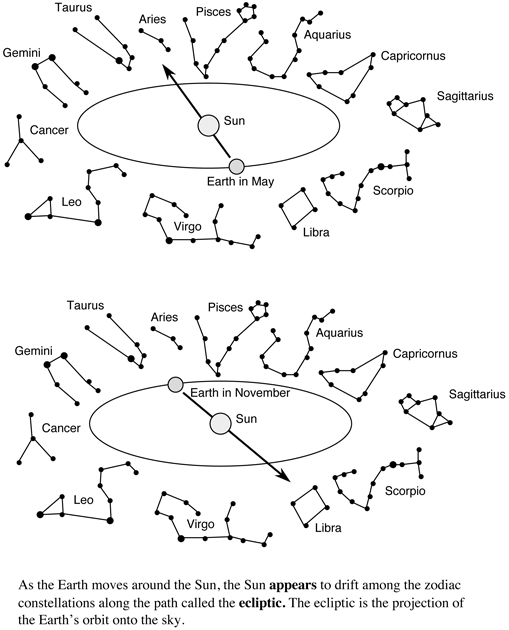
The apparent yearly path of the Lord's day through the stars is called the ecliptic. This circular path is tilted 23.five degrees with respect to the celestial equator because the Globe'south rotation axis is tilted by 23.5 degrees with respect to its orbital plane. Be sure to keep singled-out in your mind the difference between the slow drift of the Dominicus along the ecliptic during the yr and the fast motion of the rising and setting Sun during a twenty-four hour period.
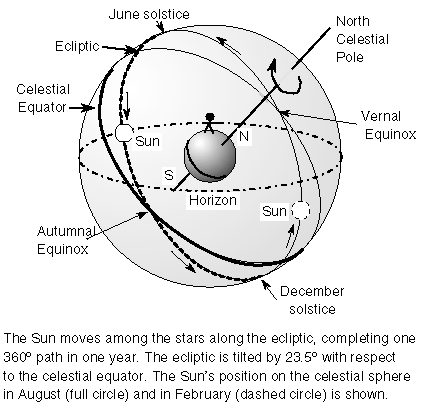
The ecliptic and celestial equator intersect at 2 points: the vernal (jump) equinox and autumnal (fall) equinox. The Sun crosses the celestial equator moving northward at the vernal equinox effectually March 21 and crosses the angelic equator moving south at the autumnal equinox effectually September 22. When the Sun is on the angelic equator at the equinoxes, everybody on the World experiences 12 hours of daylight and 12 hours of night for those ii days (hence, the name ``equinox'' for ``equal night''). The solar day of the vernal equinox marks the beginning of the three-month season of spring on our calendar and the twenty-four hour period of the autumn equinox marks the offset of the season of fall (fall) on our calendar. On those 2 days of the year, the Dominicus volition rise in the exact east direction, follow an arc correct along the celestial equator and set in the verbal west direction.
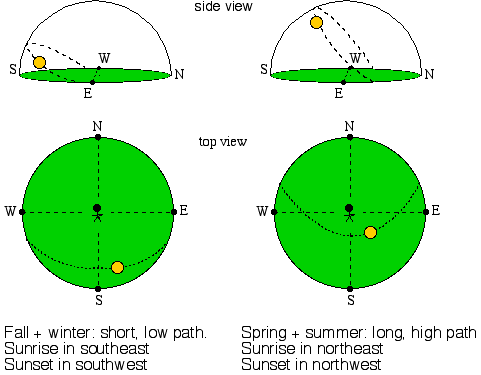
When the Dominicus is above the celestial equator during the seasons of bound and summertime, you will take more than 12 hours of daylight. The Dominicus will rise in the northeast, follow a long, high arc north of the celestial equator, and set in the northwest. Where exactly information technology rises or sets and how long the Sun is above the horizon depends on the 24-hour interval of the twelvemonth and the breadth of the observer. When the Dominicus is below the angelic equator during the seasons of autumn and winter, you will have less than 12 hours of daylight. The Sunday will ascension in the southeast, follow a short, depression arc south of the celestial equator, and set in the southwest. The exact path it follows depends on the date and the observer'southward latitude.
Make certain you lot empathize this. No thing where y'all are on the Globe, y'all volition run into ane/ii of the celestial equator's arc. Since the sky appears to rotate around you in 24 hours, anything on the celestial equator takes 12 hours to go from exact east to exact west. Every celestial object'due south diurnal (daily) motion is parallel to the celestial equator. Then for northern observers, annihilation south of the celestial equator takes less than 12 hours between rise and ready, because most of its rotation arc around you is subconscious below the horizon. Anything due north of the celestial equator takes more than than 12 hours between rising and setting because near of its rotation arc is above the horizon. For observers in the southern hemisphere, the state of affairs is reversed. Withal, retrieve, that everybody anywhere on the Earth sees i/2 of the celestial equator and so at the equinox, when the Sun is on the equator, you lot see 1/2 of its rotation arc around y'all, and therefore yous accept 12 hours of daylight and 12 hours of nightime everyplace on the Earth.
Select here for animations of the Lord's day'due south motion at two different locations on the Globe
The geographic poles and equator are special cases. At the geographic poles the celestial equator is right along the horizon and the full circle of the celestial equator is visible. Since a celestial object's diurnal path is parallel to the celestial equator, stars do not ascension or ready at the geographic poles. On the equinoxes the Sunday moves along the horizon. At the North Pole the Dominicus ``rises'' on March 21st and ``sets'' on September 22. The situation is reversed for the South Pole. On the equator observers run into one half of every object's full 24-hour path around them, and so the Sunday and every other star is to a higher place the horizon for exactly 12 hours for every solar day of the year.
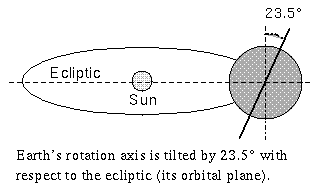 Since the ecliptic is tilted 23.5 degrees with respect to the angelic equator, the Sun's maximum athwart distance from the celestial equator is 23.5 degrees. This happens at the solstices. For observers in the northern hemisphere, the farthest northern bespeak above the celestial equator is the summer solstice, and the farthest southern point is the wintertime solstice. The word ``solstice'' means ``lord's day standing notwithstanding'' considering the Lord's day stops moving due north or s at those points on the ecliptic. The Sun reaches winter solstice around Dec 21 and you see the least part of its diurnal path all twelvemonth---this is the day of the least amount of daylight and marks the beginning of the flavor of wintertime for the northern hemisphere. On that 24-hour interval the Sun rises at its furthest s position in the southeast, follows its lowest arc south of the celestial equator, and sets at its furthest southward position in the southwest. The Lord's day reaches the summer solstice around June 21 and you see the greatest part of its diurnal path above the horizon all year---this is the 24-hour interval of the near amount of daylight and marks the beginning of the season of summer for the northern hemisphere. On that day the Sun rises at its furthest northward position in the northeast, follows its highest arc north of the celestial equator, and sets at its furthest northward position in the northwest.
Since the ecliptic is tilted 23.5 degrees with respect to the angelic equator, the Sun's maximum athwart distance from the celestial equator is 23.5 degrees. This happens at the solstices. For observers in the northern hemisphere, the farthest northern bespeak above the celestial equator is the summer solstice, and the farthest southern point is the wintertime solstice. The word ``solstice'' means ``lord's day standing notwithstanding'' considering the Lord's day stops moving due north or s at those points on the ecliptic. The Sun reaches winter solstice around Dec 21 and you see the least part of its diurnal path all twelvemonth---this is the day of the least amount of daylight and marks the beginning of the flavor of wintertime for the northern hemisphere. On that 24-hour interval the Sun rises at its furthest s position in the southeast, follows its lowest arc south of the celestial equator, and sets at its furthest southward position in the southwest. The Lord's day reaches the summer solstice around June 21 and you see the greatest part of its diurnal path above the horizon all year---this is the 24-hour interval of the near amount of daylight and marks the beginning of the season of summer for the northern hemisphere. On that day the Sun rises at its furthest northward position in the northeast, follows its highest arc north of the celestial equator, and sets at its furthest northward position in the northwest.
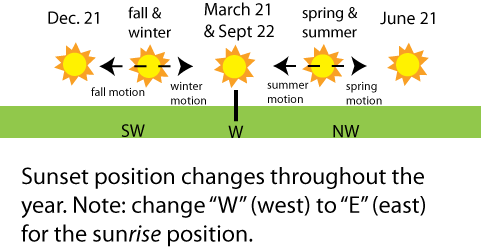
The seasons are contrary for the southern hemisphere (eg., it is summertime in the southern hemisphere when it is winter in the northern hemisphere). The Sun does not get high up higher up the horizon on the wintertime solstice. The Sun'southward rays hitting the ground at a shallow angle at mid-day so the shadows are long at mid-day. On the summer solstice the mid-mean solar day shadows are much shorter because the Sun is much higher above the horizon.
To bank check your understanding of the concepts in this department (and improve it!), go through the Motions of the Sun module of the Academy of Nebraska-Lincoln'southward Astronomy Instruction program (link will appear in a new window) and use their Motions of the Sun Simulator in the Native Apps parcel (the Flash simulators no longer piece of work with today's browsers). One section of the module will too cover solar and sidereal time that Astronomy Notes covers in a later section. The module also shows how the shadow lengths and directions change with the position of the Sunday throughout the year.
Vocabulary
| autumnal (fall) equinox | ecliptic | season |
|---|---|---|
| solar day | summer solstice | vernal (spring) equinox |
| winter solstice |
Review Questions
- How does the Lord's day move with respect to the stars during the year?
- Why does anybody have 12 hours of daylight on the equinoxes?
- Why is the length of daylight in the northern hemisphere so short on Dec 21?
- When volition the Lord's day be at its highest altitude in the year in Los Angeles or Seattle? How about Singapore (on the Equator)? Why?
- On what date is the Sun above the horizon the shortest amount of time for the Southern Hemisphere? Why?
![]() Go back to previous section --
Go back to previous section -- ![]() Become to next section
Become to next section
Get to Astronomy Notes dwelling
final updated: Jan xviii, 2022
Is this page a copy of Strobel's Astronomy Notes?
Author of original content: Nick Strobel
​what Is The Apparent Path Of The Sun Against The Background Of Stars?,
Source: https://www.astronomynotes.com/nakedeye/s5.htm
Posted by: scottworsoll.blogspot.com


0 Response to "​what Is The Apparent Path Of The Sun Against The Background Of Stars?"
Post a Comment